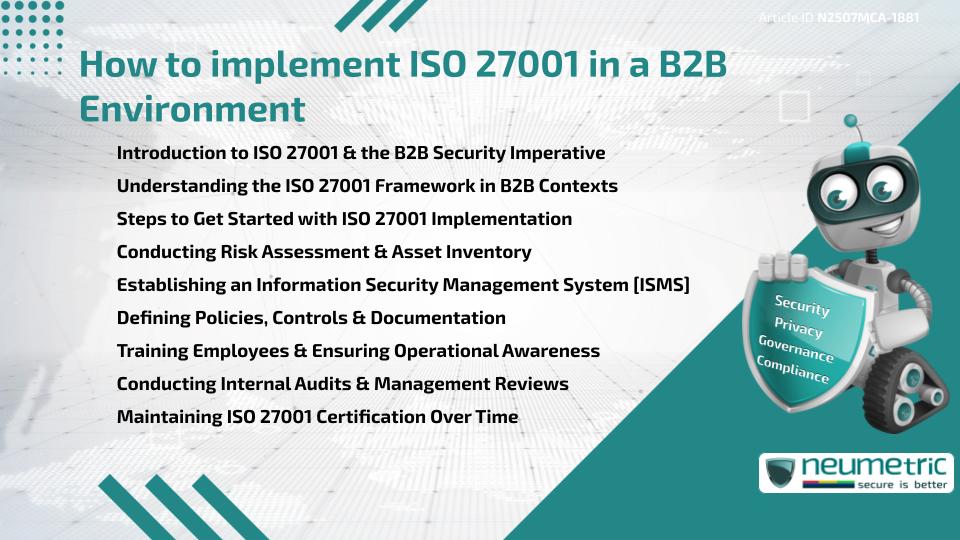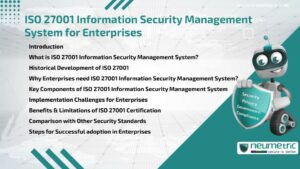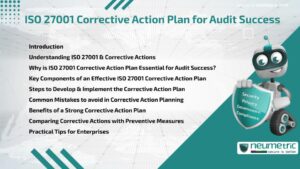Table of Contents
ToggleIntroduction to ISO 27001 & the B2B Security Imperative
Data is the backbone of modern B2B operations. Whether you are a SaaS vendor, a managed service provider or a Financial technology firm, protecting Client data is not optional. ISO 27001 offers a structured approach to safeguarding information assets by building an effective Information Security Management System [ISMS].
This international Standard helps businesses systematically manage Risks, ensure Compliance & demonstrate their commitment to Data Security. For B2B firms handling sensitive Customer Data, knowing How to implement ISO 27001 is critical for trust & operational integrity.
Understanding the ISO 27001 Framework in B2B Contexts
ISO 27001 is built around a Risk – based methodology. It focuses on identifying Threats, assessing Risks & applying controls to protect data. It also requires documentation & continual improvement.
In a B2B setting, the Framework becomes even more relevant because partners, vendors & clients often demand proof of Security Controls before entering into data – sharing agreements.
Learn more about ISO 27001 from the International Organisation for Standardisation.
Steps to Get Started with ISO 27001 Implementation
The process of How to implement ISO 27001 begins with securing Top Management support. Without Executive Buy – In, the program may lack the resources or influence to succeed. You must also define the scope of your ISMS—this includes identifying locations, systems & processes involved in data handling.
A practical first move is conducting a Gap Analysis. This tells you how close your current processes are to ISO 27001 requirements & where adjustments are needed.
Conducting Risk Assessment & Asset Inventory
At the core of ISO 27001 lies Risk Management. You need to:
- List all information assets
- Identify Vulnerabilities & Threats
- Assess potential impacts & likelihood
- Prioritise based on business Risk
B2B firms often rely on automated tools for asset discovery. However, manual reviews are also necessary to ensure no critical systems are overlooked.
Establishing an Information Security Management System [ISMS]
Once Risks are identified, the next step in How to implement ISO 27001 is building an ISMS that addresses those Risks. The ISMS should include:
- Defined roles & responsibilities
- Internal Security Policies
- Monitoring & review mechanisms
- Incident Response planning
Remember, the ISMS is not a software tool. It is a collection of processes, roles & Policies designed to protect information across its lifecycle.
Defining Policies, Controls & Documentation
You must document all controls based on ISO 27001 Annex A. This includes Access Controls, cryptographic techniques, physical security & Business Continuity plans.
In a B2B environment, sharing your policy set with partners can build trust & transparency. However, documentation must be both comprehensive & easy to understand.
Explore sample documentation structures at Advisera’s ISO 27001 toolkit.
Training Employees & Ensuring Operational Awareness
No matter how secure your systems are, human error remains a major Risk. Awareness training is essential. Your teams should know:
- What constitutes a security Risk?
- How to report incidents?
- What are their responsibilities under the ISMS?
For B2B companies, training extends beyond internal teams. Vendors & contractors should also be aware of their roles in maintaining Compliance.
Conducting Internal Audits & Management Reviews
An Internal Audit checks whether your ISMS is functioning as intended. ISO 27001 requires you to plan, execute & document these audits regularly.
Management reviews follow audits & involve leadership reviewing results to decide on necessary changes or improvements.
Using templates like those found at 27001Academy can streamline this step.
Maintaining ISO 27001 Certification Over Time
Achieving certification is not the end goal. Maintaining it requires ongoing effort. This includes:
- Continuous Improvement of controls
- Monitoring performance indicators
- Conducting regular Risk reviews
- Updating documentation when systems change
Surveillance audits by a certifying body typically occur every year, with a full recertification Audit every three (3) years.
Takeaways
- ISO 27001 is essential for B2B organisations that handle sensitive information.
- Implementation begins with leadership support, followed by Risk Assessment & ISMS creation
- Clear Policies, training & internal audits are vital components of the process.
- Certification is ongoing & requires continual evaluation & improvement.
- Learning How to implement ISO 27001 is a strategic decision that supports Compliance, trust & operational security.
FAQ
What is the first step in How to implement ISO 27001?
The first step is gaining leadership support & defining the scope of the ISMS to align with business goals.
Do B2B firms need a full ISMS to implement ISO 27001?
Yes, ISO 27001 requires a comprehensive ISMS that covers people, processes & technology.
How often should internal audits be performed?
Internal audits should be conducted at least once a year or more frequently based on business Risk.
Can ISO 27001 be implemented without hiring consultants?
Yes, it is possible, but many B2B firms choose external guidance for expertise & speed.
Is Employee Training part of ISO 27001 implementation?
Yes, it is possible, but many B2B firms choose external guidance for expertise & speed.
What kind of documents are needed for ISO 27001?
Policies, procedures, Risk Assessments, Audit plans & training records are typically required.
How does ISO 27001 help with Third Party assurance?
It proves to partners that your organisation follows globally accepted Data Protection practices.
What is the difference between Risk Assessment & Risk treatment?
Risk Assessment identifies & prioritises Risks, while Risk treatment addresses how those Risks will be treated.
Need help?
Neumetric provides organisations the necessary help to achieve their Cybersecurity, Compliance, Governance, Privacy, Certifications & Pentesting goals.
Organisations & Businesses, specifically those which provide SaaS & AI Solutions, usually need a Cybersecurity Partner for meeting & maintaining the ongoing Security & Privacy needs & requirements of their Clients & Customers.
SOC 2, ISO 27001, ISO 42001, NIST, HIPAA, HECVAT, EU GDPR are some of the Frameworks that are served by Fusion – a centralised, automated, AI – enabled SaaS Solution created & managed by Neumetric.
Reach out to us!





